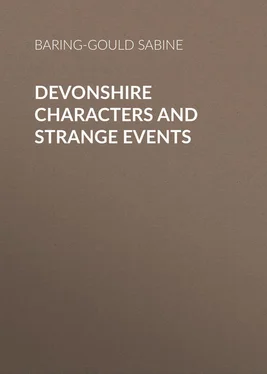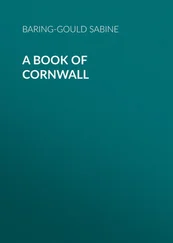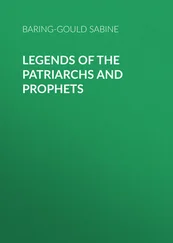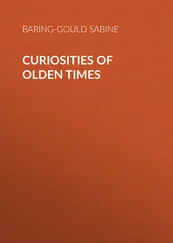Sabine Baring-Gould - Devonshire Characters and Strange Events
Здесь есть возможность читать онлайн «Sabine Baring-Gould - Devonshire Characters and Strange Events» — ознакомительный отрывок электронной книги совершенно бесплатно, а после прочтения отрывка купить полную версию. В некоторых случаях можно слушать аудио, скачать через торрент в формате fb2 и присутствует краткое содержание. Жанр: foreign_antique, foreign_prose, на английском языке. Описание произведения, (предисловие) а так же отзывы посетителей доступны на портале библиотеки ЛибКат.
- Название:Devonshire Characters and Strange Events
- Автор:
- Жанр:
- Год:неизвестен
- ISBN:нет данных
- Рейтинг книги:3 / 5. Голосов: 1
-
Избранное:Добавить в избранное
- Отзывы:
-
Ваша оценка:
- 60
- 1
- 2
- 3
- 4
- 5
Devonshire Characters and Strange Events: краткое содержание, описание и аннотация
Предлагаем к чтению аннотацию, описание, краткое содержание или предисловие (зависит от того, что написал сам автор книги «Devonshire Characters and Strange Events»). Если вы не нашли необходимую информацию о книге — напишите в комментариях, мы постараемся отыскать её.
Devonshire Characters and Strange Events — читать онлайн ознакомительный отрывок
Ниже представлен текст книги, разбитый по страницам. Система сохранения места последней прочитанной страницы, позволяет с удобством читать онлайн бесплатно книгу «Devonshire Characters and Strange Events», без необходимости каждый раз заново искать на чём Вы остановились. Поставьте закладку, и сможете в любой момент перейти на страницу, на которой закончили чтение.
Интервал:
Закладка:
John Fitz was riding over the moor one day with his wife, when they lost their direction, were, in fact, pixy-led, and they floundered through bogs, and could nowhere hit on the packhorse track that led across the moors from Moreton Hampstead to Tavistock. Exhausted and parched with thirst they lighted on a crystal stream, dismounted, and drank copiously of the water. Not only were they refreshed, but at once John Fitz’s eyes were opened, the spell on him was undone, and he knew where he was and which direction he should take. Thereupon he raised his hand and vowed he would honour that well, so that such travellers as were pixy-led might drink at it and dispel the power over them exercised by the pixies. The spring still flows and rises under a granite structure erected in fulfilment of his vow by John Fitz; it bears his initials and the date 1568 in raised figures and letters on the covering stone. Formerly it was on a slope in the midst of moorland away from the main track, near the Blackabrook. Now it is enclosed in the reclaimed tract made into meadows by the convicts of Princetown. Happily the structure has not been destroyed: it is surrounded by a protecting wall.
In the same year that John Fitz erected this well, he obtained a lease to carry water in pipes of wood or of lead through the garden of one John Northcott to his mansion at Fitzford. The little house that he built over the spring in his close, called Boughthayes, still stands, picturesquely wreathed in ivy.
He died 8 January, 1589–90, aged sixty-one, and by his will made his wife executrix and guardian of his son, who was then rather over fourteen years old. There is a stately monument in Tavistock Parish Church to John Fitz and his wife, he clothed in armour, which in life he probably never wore, as he was a man of the long robe. The effigies are recumbent, and by them is a smaller, kneeling figure of the son and heir – their only child, the “unfortunate” John Fitz. But the widow did not have charge of her son; as a ward under the Queen he was committed to Sir Arthur Gorges, “who tended more to the good of the child than his own private profit,” which was perhaps unusual. Mary Fitz retired to Walreddon, near Tavistock, another house belonging to the family, for her initials “M. F.” and the date 1591 are cut in granite over the doorway. But presently she married Christopher Harris, of Radford, when she moved to his house near Plymouth.
The young John Fitz is described as having been “a very comlie person.” He was married, before he had attained his majority, to Bridget, sixth daughter of Sir William Courtenay. Of this marriage one child, Mary, was born 1 August, 1596, when her father was just twenty-one years old. John Fitz was now of age, considered himself free of all restraint, owner of large estates, and was without stability of character or any principle, and was inclined to a wild life. He took up his residence at Fitzford, and roystered and racketed at his will.
One day (it was 4 June, 1599) he was dining at Tavistock with some of his friends and neighbours. The hour was early, for in the account of it we are told that “with great varietie of merriments and discourse they outstript the noontide.”
John Fitz had drunk a good deal of wine, and he began to brag of his possessions, and boasted that he had not a foot of land that was not his freehold. Among those present was Nicholas Slanning, of Bickleigh. He interrupted Fitz, and said, “That is not so. You hold of me a parcel of land that is copyhold, and though of courtesy it has been intermitted, yet of due, you owe me so much a year for that land.”
John started from his seat, and told Slanning to his face that he lied, and mad with rage, drew his dagger and would have stabbed him. Slanning with a knife beat down Fitz’s blade, and the friends at the table threw themselves between them and patched up the quarrel as they supposed. Nicholas Slanning then left the apartment and departed for Bickleigh with his man, both being on horseback.
They had not ridden far when they came to a deep and rough descent, whereupon Slanning bade his man lead the horses, and he dismounting walked through a field where the way was easier.
At that moment he saw John Fitz with four attendants galloping along the lane after him. Without ado, Slanning awaited the party and inquired of John Fitz what he desired of him. Fitz replied that he had followed that he might avenge the insult offered him. Thereupon Fitz called to his men, and they drew their blades and fell on Slanning, who had to defend himself against five men. The matter might even then have been composed, but one of Fitz’s men, named Cross, twitted his master, saying, “What play is this? It is child’s play. Come, fight!” Fitz, who had sheathed his sword, drew it again and attacked Slanning. The latter had long spurs, and stepping back they caught in a tuft of grass, and as he staggered backward, Fitz ran him through the body. At the same time, one of Fitz’s men struck him from behind. Slanning fell to the ground and died. He was conveyed home, and buried in Bickleigh Church, where his monument still exists, but in a mutilated condition. It was of plaster, and when the church was “restored” fell to pieces; but the curious Latin inscription has been preserved.
Nicholas Slanning had been married to Margaret, daughter of Henry Champernowne, of Modbury, and he died leaving as his heir a child, and the administration of his estates was committed to that son’s great-uncle. Of Ley, the fine Slanning place, nothing now remains except the balls that stood on the entrance gates, that have been transferred to the vicarage garden at Bickleigh. The situation was incomparably beautiful, and it is to be regretted that the grand old Elizabethan mansion has been levelled with the dust. Sir Nicholas Slanning, created a baronet in 1663, moved to Maristowe in Tamerton Foliot, but the second and last baronet died without issue in 1700, and in 1798 John Modyford Heywood, who inherited the extensive Slanning estates through a female line, sold them all to Sir Manasseh Lopes, a Portuguese Jew diamond merchant, who had obtained a baronetcy by buying up rotten boroughs in Cornwall and putting in members whose votes could be relied on by the ministry of the day. The baronetcy was created in 1805. The first baronet was the son of Mordecai Lopes, of Jamaica.
Конец ознакомительного фрагмента.
Текст предоставлен ООО «ЛитРес».
Прочитайте эту книгу целиком, купив полную легальную версию на ЛитРес.
Безопасно оплатить книгу можно банковской картой Visa, MasterCard, Maestro, со счета мобильного телефона, с платежного терминала, в салоне МТС или Связной, через PayPal, WebMoney, Яндекс.Деньги, QIWI Кошелек, бонусными картами или другим удобным Вам способом.
1
Whiteway’s Wine of the West Country .
2
They are not so represented in the three lithographs that were published at Torquay. But two others beside this correspondent mention their appearance in “bloomers.”
3
M. B. Synge, A Short History of Social Life in England . London, 1906.
4
Whitfeld, Plymouth and Devonport, in Times of War and Peace , 1890, pp. 296–7.
5
“Venez en bas, et montez le ‘Scuttle’ et allez en bas.”
Интервал:
Закладка:
Похожие книги на «Devonshire Characters and Strange Events»
Представляем Вашему вниманию похожие книги на «Devonshire Characters and Strange Events» списком для выбора. Мы отобрали схожую по названию и смыслу литературу в надежде предоставить читателям больше вариантов отыскать новые, интересные, ещё непрочитанные произведения.
Обсуждение, отзывы о книге «Devonshire Characters and Strange Events» и просто собственные мнения читателей. Оставьте ваши комментарии, напишите, что Вы думаете о произведении, его смысле или главных героях. Укажите что конкретно понравилось, а что нет, и почему Вы так считаете.












